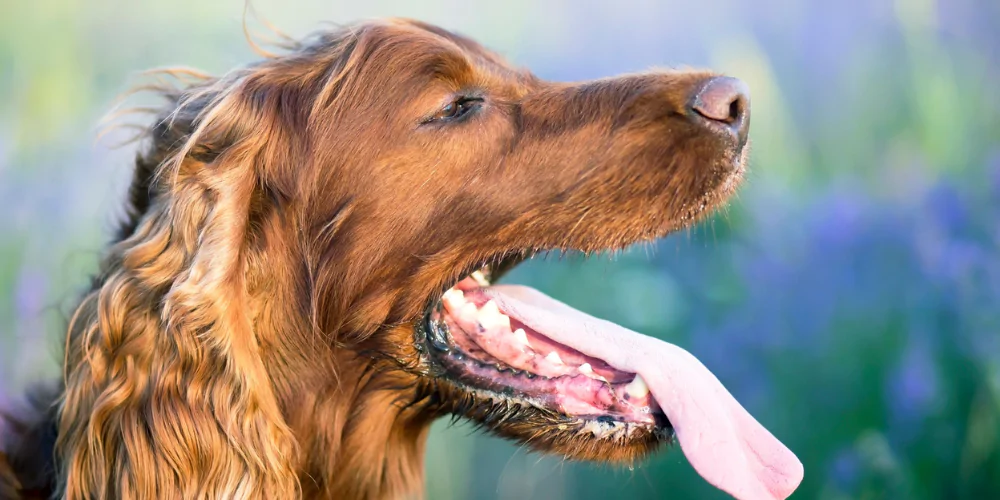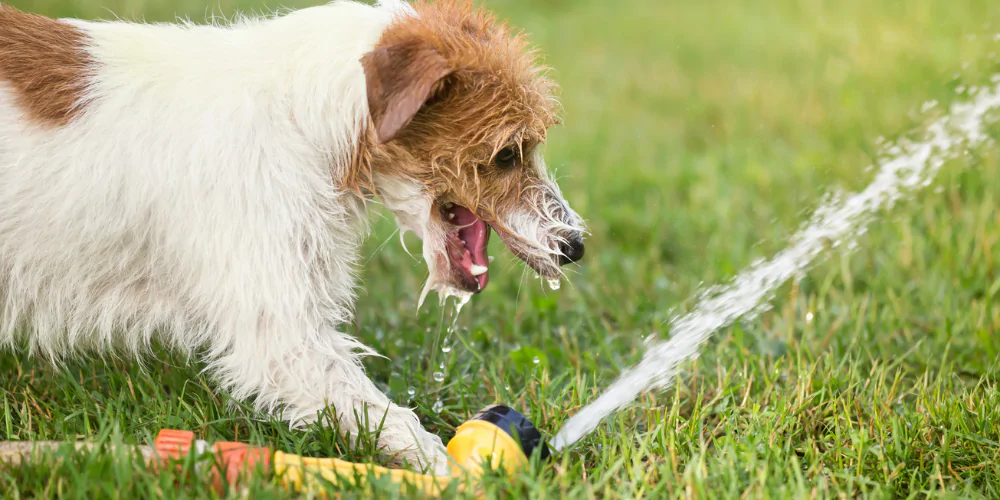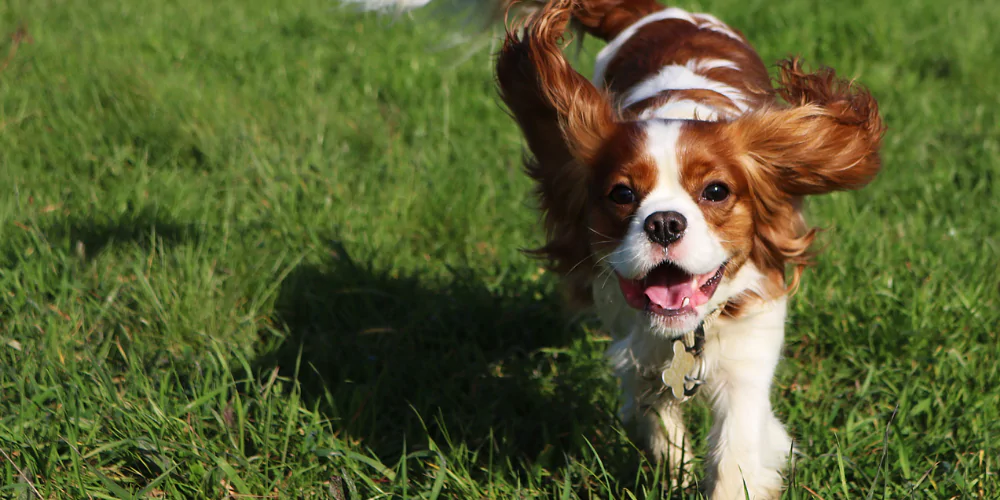
How to keep your dog cool in hot weather

Dr Rachel Cox, FirstVet vet
24 August 2021 | 6 minutes read
Sunny weather makes you want to get out and have fun with the whole family, including your canine best friend. What’s not so fun? A sick dog with a heat-related illness.
FirstVet vet Dr Rachel Cox looks at what you can do to protect your dogs throughout the hot summer months.
Table of Contents
- Signs of overheating in dogs
> Dog is panting
> Dog has disorientation and wobbliness
> Dog has bright red or blue gums
> Dog is collapsing
> Dog is vomiting/has diarrhoea
> Dog is becoming anxious, barking, whining or trembling
> Dog is seeking shade or reluctance to move
> Dog has excessive drooling or increased thirst
> Dog has mental dullness or glassy eyes
> Dog has difficulty breathing, collapsing, seizures or loss of consciousness - How to stop dogs overheating
> Can dogs overheat in the house? - Dog breeds that overheat easily

Signs of overheating in dogs
Dogs love spending quality time with their humans, including going for walks and playing active games like fetch. When the summer months roll around, there’s often even more opportunity to get outside together.
Many dogs who love to play in the summer sun get so caught up in the fun that they often don’t know when to stop. Walking dogs in hot weather can become dangerous as it can lead to overheating, especially if they don’t have access to water or shade.
There are multiple causes of heatstroke in dogs, but the most common is leaving your dog in a hot enclosed space, such as a car. It can take as little as 15 minutes for a dog to die of heatstroke in these situations.
Pets can’t communicate when they’re starting to get hot and uncomfortable. That’s why it’s our job as responsible dog owners to recognise the signs of overheating.
> Dog is panting
Panting is a common way for dogs to cool themselves down. Because they can’t sweat through their skin (as we humans do), dogs use panting instead to lower their temperature.
You’ll often notice your dog panting after an activity or when they’re excited (which is pretty much every time you come back into the room).
Constant panting without any relief, though, can be one of the first signs of overheating or overexertion. It’s important to monitor your pup for this kind of excessive panting in hotter weather.
> Dog has disorientation and wobbliness
Disorientation and wobbliness is an easier sign to spot in dogs. If you notice that your pooch is falling down, walking in circles, unable to stand, walking shakily, or if their head is tilting to one side, they could be feeling disorientated. This can become more severe over time.
It’s important to treat your dog as soon as you notice any disorientation to avoid further health issues. If your dog still isn’t their usual tail-wagging self after some shade and water, they’ll need to see a vet.
> Dog has bright red or blue gums
Bright red/purple coloured gums that feel dry are another sign that your pooch is suffering in the heat. A lack of oxygen can then lead to the gums turning blue, which is a significant telltale that your dog is overheating. Should this happen, act quickly and get to your vets.
> Dog is collapsing
Another indication of heatstroke is your dog collapsing. The severity increases if this is paired with any of the other signs of overheating. If your dog collapses, you’ll need to immediately take them to the vet to avoid any serious consequences.
> Dog is vomiting/has diarrhoea
Heatstroke can cause vomiting and diarrhoea. While these are common problems in dogs, if they occur alongside other signs of heatstroke, you need to take rapid steps to cool your dog or contact your vet.
> Dog is becoming anxious, barking, whining or trembling
There are many things that can upset your dog and make them anxious, bark, whine or tremble. Changes in the environment (such as new people/animals or the absence of a loved one) can cause these behaviours, but it may also indicate they are distressed by the heat.
> Dog is seeking shade or reluctance to move
Are you struggling to get your dog to move? Are they actively trying to avoid the sun? These could suggest they are suffering from heatstroke. Dogs who are struggling to cool down may choose to rest and stay out of the sun as a coping mechanism for avoiding heat.
> Dog has excessive drooling or increased thirst
Similar to anxious behaviour, look at excessive drooling or increased thirst in the context of your dog’s environment. Although your dog may drool at the prospect of getting their favourite snack, excessive drooling on a hot day could suggest they have heatstroke.
This logic can also be applied to increased thirst. Lots of pups are thirsty after a long walk, but continuous drinking with no sign of being satiated could indicate they have overheated.
> Dog has mental dullness or glassy eyes
If your dog’s movements and reactions are slower, won’t respond to their commands or their eyes are looking particularly glassy, it’s important to seek medical help. Mental dullness and glassy eyes are more worrying signs of heatstroke, so acting quickly is in the best interests of your pup’s health.
> Dog has difficulty breathing, collapsing, seizures or loss of consciousness
These are the most severe signs of heatstroke and may have the most negative consequences on your dog’s health. If any of these signs occur, it’s crucial that you take your dog to an emergency vet to receive treatment.

How to stop dogs overheating
No one wants to see their dog suffer. There are a few things you can do at home to help in the earlier stages of overheating. If your dog shows any of the signs mentioned, you can:
- Move the dog to a cooler and less crowded area so they’re directly out of the heat.
- Actively cool your dog down. You can use cool water with a sponge or give them a cool shower to help reduce their temperature. It’s important that you don’t submerge your dog’s head in water as this can cause aspiration pneumonia.
- You can also place cold wet towels on your dog’s stomach, armpits, and pads to help cool them down. Be sure to change these towels frequently as they can trap heat and make the problem worse. Placing a fan near to your pooch will help to circulate air around them.
- Before taking your dog out, place your hand on the ground for seven seconds. If the ground is hot and uncomfortable to touch, avoid heading outside. Wait until it cools down to take your pup for a walk, such as in the evening.
> Can dogs overheat in the house?
A hot and stuffy house can be just as damaging to your dog’s health as the inside of a hot car. Monitoring the temperature of your home during a heatwave can help to keep your canine safe. A few things you can do to maintain a cool home for your dog include:
- Closing the curtains to keep the sun out.
- Keeping your dog out of areas with strong or consistent sunlight throughout the day, such as south-facing rooms.
- Making icy treats by freezing meat, raw chicken and beef bones, or fruit.
- Hydrate them! Freeze your dog’s water bowl and keep it topped up with fresh cold water.
Every dog reacts differently to heat. Young dogs, small dogs, obese dogs, hairier dogs, and those with health conditions can be more susceptible to heatstroke. Take the time to understand your dog and its individual needs in hot temperatures.

Dog breeds that overheat easily
It’s worth noting that some dog breeds are more susceptible to heat than others. These include:
- Flat-faced dogs such as the Chow Chow, Bulldog, French Bulldog, Dogue de Bordeaux, and Pug.
- Sport breeds like Greyhounds, Golden Retrievers, and Springer Spaniels.
- Toy breeds such as Cavalier King Charles Spaniels.
We think pet prejudice is barking mad and your pooch deserves to be treated fairly. Discover why we’re fighting for more inclusive dog insurance.


